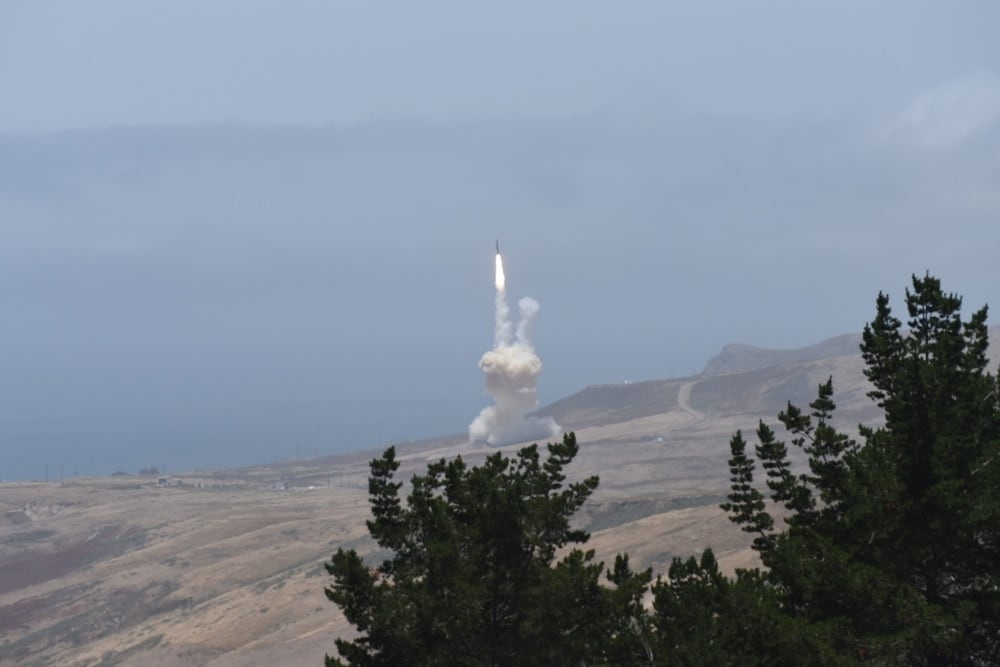WASHINGTON — The Missile Defense Agency successfully launched a mock-up of a kill vehicle with a new three-stage booster designed to enhance the performance of the interceptors that make up the Ground-Based Midcourse Defense System in a Sept. 12 flight test, according to an agency statement.
The GMD system is designed to protect the homeland from intercontinental ballistic missiles from Iran and North Korea.
The launch of the mock-up Exoatmospheric Kill Vehicle, or EKV, was the first flight test of a three-stage booster operating in two-stage mode “meaning the third stage was not ignited, allowing earlier release of the kill vehicle providing increased battlespace,” the statement said.
RELATED

The EKV is the section of the Ground-Based Interceptor (GBI) designed to destroy targets in high-speed collisions after separating from the booster rocket.
This new booster capability — known as the “2-/3-Stage selectable GBI” — gives the “warfighter greater flexibility in executing the defense of the homeland while significantly increasing the battlespace for successful threat engagement,” MDA said.
The agency used a mock-up of an EKV to reduce the test cost and keep its critical defense assets available, the statement noted.
“Initial indications show the test met requirements,” but program officials will continue to evaluate the data to determine system performance, the statement added.
“The system worked exactly as it was designed to do, and the results of this test provide evidence of the greatly increased battlespace the selectable booster brings to the Warfighter,” MDA Director Vice Adm. Jon Hill said in the statement.
“The Ground-Based Midcourse Defense system is vitally important to the defense of our homeland, and this test demonstrates that we continue to provide enhanced capabilities for our existing Ground Based Interceptor fleet while we rapidly design and deliver the leap ahead technology of the Next Generation Interceptor,” he added.
The new selectable stage booster provides more engagement time and space, the agency said, and future upgrades to sensing and tracking capabilities will offer the ability to “assess the threat after initial engagement while retaining the time to engage again if necessary.”
Hill said getting the booster capability is “our first step toward a robust ‘shoot-assess-shoot’ capability.”
The agency is working on upgrading and performing a Service Life Extension Program (SLEP) for its GMD system as it races toward adding roughly 20 Next-Generation Interceptors (NGI) to an inventory of 40 GBIs already in the ground at Fort Greely, Alaska. There are four other GBIs at Vandenberg Air Base, California.
Fielding the NGI is expected to take place beginning in 2028, with the last being emplaced by roughly 2030.
It is possible the Pentagon may decide to replace current GBIs with NGIs, but the decision to do so will be down the road.
MDA canceled a previous attempt to redesign the EKV in 2019 due to difficulty meeting technical requirements, so the pressure is on to ensure the GBI system has interceptors capable of destroying ever-evolving ICBM threats.
The new booster capability is expected to be integrated with the current GBI fleet over the next couple of years as part of the ongoing GMD SLEP efforts.
Jen Judson is an award-winning journalist covering land warfare for Defense News. She has also worked for Politico and Inside Defense. She holds a Master of Science degree in journalism from Boston University and a Bachelor of Arts degree from Kenyon College.






